|
Features,
Honors
& Awards, Ag
Announcements
Ag News Elsewhere
(fresh daily from the Web)
|
|
Features
|
|
Crops
progress
[APRIL
22, 2002] With
some rain falling over the weekend, a much-needed rest is occurring
for some farmers. Others are frustrated, as they waited for warmer
soils and a calendar date closer to optimal planting time. Rainfall
amounts varied considerably depending on whether areas received the
Friday night rain or not. Friday night totals for areas Broadwell
and south were at least a half-inch, while Saturday night totals
were in the ballpark of an inch and a quarter.
|
|
Corn
planting progress has approached the 75 percent completed level, with many
producers done. Other producers havenít started yet due to other farming
operations and wet, cold soil conditions. While we did have a run-up in soil
temperatures, going from the upper 30s a few weeks ago to the lower 70s last
week, weíll have the soil temperatures rapidly fall due to colder air
temperatures and cloudy conditions. The soil temperature this morning was 46
degrees, and the office had 1.1 inches of rain.
Corn
that has been planted for over a week is now up and growing. Germination
appears to be quite good in early-planted fields. Most fields that have
emerged corn took less than a week for the corn to get out of the ground,
and some took as little as four days.
The
rain was very welcome for most farmers for two reasons. First, a little rest
was definitely needed. The rain gives an opportunity to do some maintenance
and repair work as well. Second, the soil conditions had become very dry in
the top layer, with the hot and windy conditions. In some worked ground, the
soil had actually dried out to a depth of 4 inches. And of course, corn canít
germinate in dry soil.
[to top of second column in
this article]
|
Changing
subjects, winter wheat looks spotty this year. Sure we had good
stands and there have been very good growing conditions. But, a
viral disease called barley yellow dwarf has come into some wheat
fields with a vengeance. This disease can cause severe yield losses.
It is a virus that is transmitted by an insect, and no doubt it was
helped greatly by the milder winter weather we experienced.
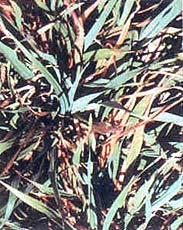
Whatís
left? The next break in the weather will see the corn planters
finish rolling. Then will come soybean planting. Typically farmers
will wait until the last week of April to begin planting soybeans,
as they are more affected by a late frost than corn is. The soybean
seed also wonít germinate as well in cooler soil, and much of our
soybean seed this year probably doesnít have the quality and vigor
it might have. This is due to the type of growing season we had last
year.
[John
Fulton, Logan County Unit,
University of Illinois Extension]
|
|
|
Fourth-graders
explore agriculture through hands-on activities
[APRIL
12, 2002] Fourth-graders
from every school in the county learned that "Agriculture is
Everywhere" Thursday, courtesy of a fair put on by a committee
of the Logan County Farm Bureau.
[Click here to view more
photos]
|
|
Gathering
at the Logan County Fairgrounds, the youngsters participated in activities
ranging from playing soybean bingo to shaking up ice cream and plastic ooze.
Along the way they met piglets, lambs and a 6-month-old heifer.
The
highlight of the day was a sheep-shearing demonstration performed by Steve
Schreiner of rural Lincoln. Counting morning and afternoon sessions, close
to 350 students circled him on the textile-building floor, remaining in
their spots even when it appeared those on the other side would have a
better view. There were gasps of "Whoa!" as Schreiner pulled the
sheep to its feet to begin. A few hands flew to faces as his clippers neared
the chin and face. After the shearing and a few questions ó Does it hurt
the sheep? Does it hurt you? ó there was a mad dash to the center as
Schreiner offered free samples of wool, teacher permitting. He said he found
his afternoon sheep much more cooperative than his morning project.
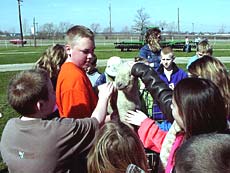
[Photos by Bob Frank]
Earlier,
Schreinerís son Matt, owner of the sheep on display, encouraged children
to pet his 1Ĺ- to 3-week-old lambs. He said the Southdown sheep are noted
for their meat more than their wool, for which he gets about 5 cents a
pound.
Lynn
Paulus, Farm Bureau chair for ag in the classroom, said fourth-graders were
chosen for the event because they are old enough to take in quite a lot of
information yet still love to learn and are excited about finding out
something new. In addition, they are an age group little served by other
outreach activities.
Volunteers
from the Farm Bureau and from Hartsburg-Emden, Lincoln and Mount Pulaski
Future Farmers of America chapters led hands-on activities highlighting
dairy, pork, corn and soybean production and farm machinery. For one, Mount
Pulaski FFA member Brian Toohill introduced the students to a 6-month-old
Holstein heifer while supplying them with facts such as that one animal can
give about 15,000 gallons of milk per year.
Students
played soybean bingo with cards on which the squares named products made
from soybeans, such as glue, yogurt and crayons. The markers were kernels of
corn. Apparently soybeans are too small for the purpose.
Another
project was to create plastic ooze by shaking a bag of cornstarch, corn oil
and food coloring to mix the ingredients, then microwaving. The result ó a
brightly-colored blob of malleable plastic.
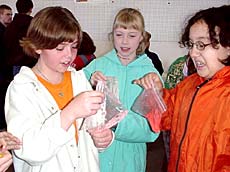
[to top of second column in
this article]
|
At
the pork station youngsters first heard from Vicki Huelskoetter, a member of
the ag day committee, about what pigs eat and what foods come from them.
Next they made "feed bags" full of snacks representing the
elements that go into hog feed: M&Ms stood for vitamins, blue jelly
beans for water, raisins for minerals, peanuts for protein, and both candy
corn and puffed wheat for energy. After snacking, children had an
opportunity to touch a baby pig held by Kent Paulus, local Farm Bureau
president.
The
ag day committee consists of Lynn Paulus, Huelskoetter, Schreiner,
Mary Lou Klokkenga and Farm Bureau manager Jim Drew. This was the
second Agriculture is Everywhere fair, and Huelskoetter said next
yearís event will be revised in light of this yearís results.
The
children learned that Logan County agriculture means food
production, and they had plenty of opportunities to experience the
end product. At the food-tasting table they could sample chocolate
soy milk and soy butter that mimics peanut butter. The table also
displayed oils from corn and soybeans, assorted packaged cereals,
and the raw grains they are made from.
At
another station fourth-graders put mixtures of sugar, vanilla,
half-and-half and milk into a bag with ice, salt and a little water.
After vigorous shaking some managed to make their mixtures solidify
into ice cream. Others produced something more like a milkshake.
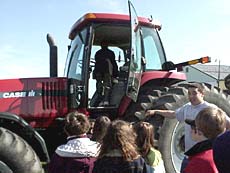
The
farm machinery station offered the opportunity to view a 12-row corn
planter and to climb onto the tractor. The cab was equipped with air
conditioning, radio and stereo, but several youngsters from
Hartsburg-Emden were not impressed. "Weíve seen it all
before," they said. "This tractor doesnít have a TV like
Christopher (Crane)ís dadís does."
Despite
this group wise to the ways of farm machinery, Paulus said one
reason for the fair is that even most youngsters living in rural
communities do not live on working farms, though they may have
relatives who do. Itís important that they understand the
importance of agriculture and the work it entails, she said.
The
event was originally planned for March to coincide with National Ag
Day but was postponed because of weather. Paulus said the delay
turned out to be a good thing, producing not only a better day but a
larger audience as well. Two classes with conflicts in March were
able to attend in April, making for 100 percent attendance of county
fourth-grade classes.
Following
the fair, participants may enter an Agriculture is Everything essay
contest. Phi Theta Kappa honor society students from Lincoln College
will select the five winners. Committee member Steve Schreiner said
that winners were announced at the fair last year. This year the
timing was changed to allow students to incorporate what they have
learned.
[Lynn
Shearer Spellman]
|
|
|
Planting
corn
[APRIL
8, 2002] One
of the sure signs of spring is when the corn planters come out of
the shed and begin the annual ritual of planting the fields. While
it may look like farmers just drive back and forth in the fields,
there is a lot of planning and skill involved in this farming
operation.
|
|
Last
year the typical farmer began choosing which hybrids he would plant this
year. He used yield data from plots, company information and his own
experience. He also had to make note of certain insect and disease problems
in various fields to select hybrids that were resistant, or more tolerant,
to those conditions. The farmer also had to select varying maturities of
corn so that harvest would be spread out over a period of time to avoid
losses in the field.
The
planting date is critical for success. University research shows that the
optimum time to plant corn in our area is the last week of April. After that
date, there is about a 2 percent yield loss for every five days of delay.
There is also a slight yield loss for planting early, but it is usually less
than the late planting penalty. The other "wild card" is that on
average there are only 3.1 days available for field work between April 21
and April 30. There are only 4.3 days available on average for the May 1-10
period. This points out the need for timely operations for the farmer.
Another
criteria for planting is the soil temperature. Corn germinates at about 50
degrees soil temperature (at the earliest). Right now we are about eight
degrees under that. Leaving seed in the ground longer than it needs to be
can cause insect and disease problems.
Corn
should also be planted between 1.5 and 2 inches deep early in the season.
Later on the corn usually has to be planted deeper to reach moisture. This
means the farmer has to adjust the planter to plant corn into moisture in
about that depth range. The farmerís goal is to have all the corn come up
at the same time so that earlier plants donít compete with later ones.
[to top of second column in
this article]
|
The
number of plants per acre is very important. With the current
varieties, the farmer will get the most yield from about 30,000 to
32,500 plants per acre. He has to plant a little more than that to
allow for seed loss to insects, diseases, birds and mice. Our farmer
will lose 2 to 3 percent of his yield for every 2,500 seeds that donít
grow.
The
last discussion item for today is row width. You can see the rows of
corn after the seed comes up. The most common row width is 30 inches
now. It used to be 40 inches, then 38, then 36, and now it is 30.
The trend is to get narrower. The wide rows we used to use were
based not on yield, but rather on being wide enough to get the
horses the farmer used to use down those rows. Now we are worried
about yields, and the 30-inch rows allow for more space between
kernels in a row.
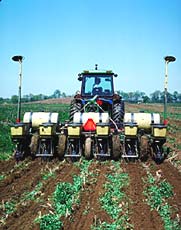
Add
to this the fact that we havenít even discussed the fertilizer,
herbicides, insecticides and other management factors, and you can
see that planting corn is definitely more that driving the tractor
with the corn planter trailing behind. And we canít forget Mother
Nature. She ultimately has control regardless of what our farmer
does.
[John
Fulton, Logan County Unit,
University of Illinois Extension]
|
|
|
Spring
is here and itís time
to plant; hold that thought
[MARCH
30, 2002] Now
that Illinois has had a few days with freezing rain and snow,
gardeners and farmers alike are eager to begin their spring
planting, but they still need to wait a bit longer and keep frost
dates in mind.
View
spring frost map for Illinois
[The
map is an Adobe Acrobat file. Click
here if you need to download Adobe Acrobat Reader.]
|
|
"The
last spring frost usually occurs between April 7 (southern Illinois) and
April 28 (northern Illinois), and April 14 to 21 (central Illinois), based
on 1971-2000 averages," says Jim Angel, state climatologist with the Illinois
State Water Survey.
"The
actual frost date varies quite a bit from year to year," says Angel. He
suggests adding two weeks to the average frost date for your area before
planting tender plants, to protect them against the possibility of a late
season frost. "By doing so, the odds are only 1 in 10 that frost will
occur later in spring," continues Angel.
Although
32 degrees Fahrenheit is the temperature traditionally used to identify
frost, visible frost can be seen on the ground and on objects at slightly
warmer temperatures on calm, clear nights that allow cold, dense air to
collect near the ground. Under these conditions, the temperature near the
ground actually can be a few degrees cooler than at the 5-foot height of the
official National Weather Service thermometer.
Open,
grassy areas usually experience frost first, while areas under trees are
more protected because the trees help prevent the heat from escaping.
Covering tender plants when a frost is expected can provide this same type
of protection. Plants near heated buildings sometimes are spared too. An
abundance of warm buildings and trees in town means that urban areas tend to
have frost less often than rural areas.
[to top of second column in
this article]
|
According
to Angel, average high temperatures in spring (March-May) range from
the upper 50s (north), to the low 60s (central), to the upper 60s
(south), while the average low temperatures range from the upper 30s
(north), to the lower 40s (central), to the upper 40s (south).
Data
from the Water Survey WARM Network also indicate that soil moisture
across the state is near to above average for this time of year.
"Donít
let the mild winter weíve had fool you into thinking weíll have
a warm spring," cautions Angel. "Historical data indicate
that warm springs do not follow warm winters. Although there is a
tenuous relationship between warm Aprils and earlier dates at which
the last spring frost occurs, it only takes a day or two of
unseasonably cold weather to produce a late spring frost," he
said.
[Illinois
State Water Survey, a division of
the Illinois Department of Natural Resources]
|
|
|
Honors
& Awards
|
|
Logan
County 4-H Oral Communications
Contest results
[APRIL
29, 2002] Logan
County 4-H recently had its annual contest in oral communications.
State fair delegates selected included Emily Bakken, Lincoln, with
an illustrated speech; Amanda Davison, Beason, illustrated speech;
Andrew Fulton, Lincoln, formal speech; Abrigail Sasse, Beason,
original works; Kim Turner, Atlanta, illustrated speech; and Katie
Turner, Atlanta, illustrated speech. Selected as a state fair
alternate was Allicent Pech, Lincoln, formal speech. All were Blue
Award winners. Abrigail Sasse was selected as the top oral
communicator and received a plaque sponsored by Lincoln IGA.
|
|
Additional
Blue Award winners were Colleen Pech, Daniel Parson, Elizabeth
Carter, Rebekah Crider, Shelby Kottemann, David Fulton and Daniel
Fulton, all of Lincoln, and Lucas Munson of Beason. Shelby Kottemann
was also chosen to receive a Top Rating Award.
Judges
for this yearís contests were Ed Jodlowski of Atlanta and Doug
DeMay of Lincoln.
Oral
communication is a life skill taught and practiced in 4-H. To find
out more about the program, contact the Logan County Extension office,
980 N. Postville Drive in Lincoln, phone 732-8289.
[Patty
Huffer, Logan County Extension
community worker]
|

|
|
 |
|
|
Ag
Announcements
|
|
Public
service announcement from Curless Flying Service
Aerial
application
[APRIL
15, 2002] For
decades farmers in central Illinois have taken advantage of the
benefits of agriculture aviation. However, the events of Sept. 11
have heightened the concerns of Americans, and we at Curless Flying
Service want to offer some facts that may calm your fears.
|
|
Curless
Flying Service is doing everything we can to maximize security.
Aerial application is highly regulated by the DOA, FAA and other
departments. Aerial applicators are well-trained professionals who
take very seriously their responsibility to protect the safety of
their neighbors, employees, the public and the environment. The ag
aviation industry has been recognized by government officials,
regulatory agencies and local law enforcement for the steps it has
taken to make sure spray planes do not represent a means for
terrorist attacks. Our industry is legal to fly.
Please
remember that our yellow and blue agricultural aircraft will be
flying very low altitudes to do a very specific job. Normal
operation hours are from daylight to dusk. Application of ag
products is intentionally done at low rates, so observers might see
the same field treated more than once.
|
We
understand the fascination with watching these planes work but caution
is appreciated. We suggest that people stay away from the area being
treated to allow a safety net for both themselves and the pilot.
Anyone
with questions regarding aerial agriculture is welcome to call our
office. Curless Flying would like to thank you in advance for your
patience and understanding as we work to enhance the productivity of
area crops.
Thank
you.
Curless
Flying Service, Inc.
(309)
759-4826
|
|
|
New
beef organization formed
[APRIL
8, 2002] Beef
producers from the Logan, Mason and Tazewell County areas have
recently formed the Heartland Beef Alliance. The object of this
new group will be to share ideas on beef
production, highlight educational benefits of beef to the
consumer, tour beef production facilities, learn from guest
speakers and enjoy socializing among area producers. Any beef
producer, whether owner of one or many beef animals, is encouraged
to join.
|
|
For
more information contact the following officers: Jason Miller,
president, (309) 247-3231; Troy Gehrke, vice-president, (309)
244-7826; Betsy Pech, secretary, (217) 732-4384; or Rick McKown,
treasurer, (217) 648-2712.
The
next meeting will be June 3, 7:30 p.m., at the Greenhaven
Animal Clinic in San Jose.
|
|
|